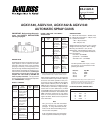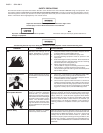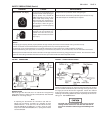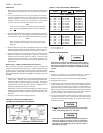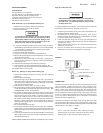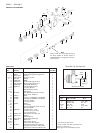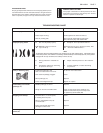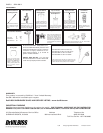
SB-2-628-K PAGE 3
INSTALLATION
Mount the gun with the stud (13) or on a 5/16" dia. rod tightening
adequately with the 1/4-28 X 1/4" set screws (Ref. 24). See "ACCES-
SORIES" for mounting clamps.
Note
If replacing the atomization air connection (15) with an
elbow type connection, be aware of a possible air flow
(CFM) limitation. A 1/4" (6.4 mm) I.D. 90° elbow will only
pass 20 CFM @ 40 psi (566 l/min. 2.7 bar). Some air caps
require more than 20 CFM (566 l/min.). Spray performance
could be affected.
Attach the trigger/cylinder air hose and the atomization air hose to
the connections as indicated by the markings on the gun body. The
air supply should be filtered and regulated. Attach the material
hose to the fluid inlet on the gun body. Fluid can be recirculated by
installing a fluid fitting (AGX-415) (order separately) at the recircu-
lating port. See Caution below.
The fluid inlet and recirculating ports have a tapered
seating surface intended for use with the AGX-415 fit-
ting. Do not substitute other fittings as fluid leakage will
occur.
FIGURE 2 TYPICAL INSTALLATIONFIGURE 1 DIMENSIONS
SAFETY PRECAUTIONS (Cont'd)
Always wear ear protection when using the gun.
Details of actual noise levels produced by the various air cap/
fluid head setups are available upon request.
Noise Levels – Ear Injury
A continuous A-weighted sound
pressure level of this spray gun
(spray pistol) may exceed 85
dB(A) depending on the air cap/
fluid head setup being used.
Sound levels are measured us-
ing an impulse sound level meter
and analyzer, when the gun is
being used in a normal spraying
application.
HAZARD CAUSE SAFEGUARDS
Wear eye protection.During cleaning and flushing,
solvents can be forcefully ex-
pelled from fluid and air pas-
sages. Some solvents can cause
eye injury.
Solvent Spray
Misuse:
• All spray guns (spray pistols) project particles at high velocity and must never be aimed at any part of the body.
• Never exceed the recommended safe working pressures for any of the equipment used.
• The fitting of non-recommended or non-original accessories or spare parts may create hazardous conditions.
• Before dismantling the equipment for cleaning or maintenance all pressure, air and materials, must be isolated and released.
The disposal of waste materials must be carried out in an approved manner. Burning may generate toxic fumes. The removal or waste
solvents and coating materials should be carried out by an authorized local waste disposal service.



